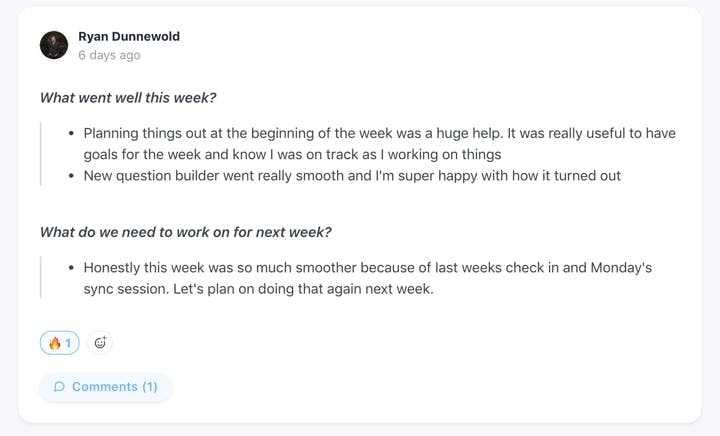How To Update Your Boss In a Helpful Way

Completed a campaign? Check.
Increased app sign-ups? Check.
Lost a client? Ouch but check.
Hit your quarterly goal in two months? Done and done.
There’s a lot that goes on in your week, month, and quarter. But if you’re the only one with access to all that information–and no one really knows the efforts you’ve been putting in and how they’re impacting the company’s bottom line–then is it truly helping your career? Or your boss?
The assumption that your boss knows all the obstacles you’ve faced and the progress you’ve made is just that...an assumption. They won’t know unless you make it a point to update them.
Now, all bosses are not the same. You need to understand their personalities, operating style, and determine what kind of information to share and in what format. For example, do they like getting weekly updates on an email? Or do they prefer that you explain what activities you have been doing and how are they helping you reach a goal on a weekly or monthly call?
Do they like little details or just want the big picture?
Even if you have regular stand-ups with your boss, they may want to hear more frequently from you. Or they may prefer that you batch all your updates and questions and ask them in your one-on-one that happen once a month. Don't assume–ask.
Having this clarity and the points below will help you update your boss in a helpful way.
How do you give good updates to your boss?
Being prepared is by far the best way to update your boss. Know what the agenda of the meeting is, what you want out of it, and what you’re going to say before walking into the meeting. Make a list of everything you want to cover and make sure they are in order of priority.
"The mark of a great man is one who knows when to set aside the important things in order to accomplish the vital ones," said Brandon Sanderson, American author.
Never walk into a meeting unprepared. Make a list of all the updates even when there’s no clear agenda and have a plan for how it will be addressed.
How do you give updates to your boss by email?
If you’re sending updates on an email, make sure the content is brief and well-formatted. Add bullet points and tables wherever possible. Color code the email but avoid going overboard with that.
Keep the email short and don’t go into too much detail. If you need more information or have questions, create a separate section and mention it there. Don’t add attachments unless absolutely necessary. Make the email easy to browse.
How to present your achievements to your boss?
Presentation is everything. It’s crucial that you present your achievements and losses in a way that’s clear, concise, and easy to consume. You should be able to communicate everything you’ve done, why it is important, and how it has helped the company. If it has led to an increase in sales or saved money, highlight that in your report.
Amy Rees Anderson, managing partner of REESCapital, an angel investing firm says, “A person who feels appreciated will always do more than what is expected.”
A good rule to follow is to focus on results more than activities. If you were to divide the two in a pie chart, 85% of it would be dedicated to results and 15% to activities.
What is the right way to bring a problem to a boss?
With work, it’s not always sunshine and rainbows. You’ll have your fair share of problems but how do you address them to your boss? Again, like everything else, being prepared is the best way to go about it.
Make sure you know what the issue is and have given it enough thought. Go to your boss with a plan for how it will be addressed. As Marshawn Lynch, the American football player, said, “I’m just ’bout that action boss.”
Address the problem in a way that doesn’t make your boss defensive. This is more about ensuring that they know what’s going on than coming in and solving the problem for you. You want to make sure that they know that you are trying to help them and the company by bringing up the issue.
How do you have a successful one-on-one with your boss?
One-on-ones are a fantastic way to not just update your boss but also get feedback from them. It’s also a good time to ask for resources that you need to do your job better. One-on-ones offer a tremendous opportunity to discuss everything that’s important as your boss will be giving you their undivided attention.
Just like every other meeting, make sure you’re prepared for this. Have all your important points ready and be clear on what you want to get out of the meeting.
How do you manage up?
Managing up is about using the qualities of a good boss to help bring out the best in you as a team member. When done effectively, managing up makes your boss’ job easier which makes you prove yourself as credible and dependable.
Managing up is important. It proves that you’re aligned with your boss and can work well with them. A key skill here is communication–sharing information effectively and efficiently. Something as simple as preparing for meetings in advance and showing up on time can help you manage up. Think from your boss’ perspective and highlight what’s most important to them and give them information that’s useful, especially with the bigger picture.
“The biggest reason people suck at managing up is because they don’t actually understand their boss’s job — but almost always think they do. Building context is hard to do, because you only see a small sliver of what your manager does, and each step of the management hierarchy brings different problems,” says Varun Srinivasan, former Senior Director of Platform at Coinbase.
How do you offer constructive criticism at work?
Giving criticism is a skill. It is important that you are able to offer constructive criticism in a way that doesn’t make the other person feel bad. You want to be able to give them feedback in a way that they can understand and use to make themselves better at their work. Be clear and concise when you give someone feedback. Criticism has to be about the task and not the person. Differentiate the two and if possible, try to find something positive about what they have done before you give them constructive feedback.
Why is it important to keep your boss updated?
Delivering good work and being reliable is a confirmed way of building trust. Another way is ongoing, consistent, and effective communication especially since your boss has their own set of responsibilities and can’t watch over you every minute of every day.
Knowing how to update your boss in a helpful way is a great way to build trust with them and manage up.
- Your boss needs to know what’s happening in the company, if there are any problems, and how they can be resolved.
- Your boss needs to know about your achievements. They want to ensure that you’re doing a good job and reward you for it.
- Keeping your boss updated is also a great way to move up in the company because consistent communication not only builds a positive relationship but also builds trust.
How Friday Can Help Keep Your Boss Updated
1. Weekly Check-Ins
For a regular check-in with your boss, written communication is the way to go. There’s no real reason this should require a meeting, unless there’s some kind of collective decision-making to do.
Essentially, if you’re working on a complex project where you and your boss need to discuss an important issue, be creative, and make decisions, an in-person, synchronous meeting is a good choice.
Use the Friday Weekly Check-In for free.

2. Team Status Updates
You can also use weekly updates to understand how your team’s current projects are going. Here’s what Eric Yaverbaum, CEO of Ericho Communications, asks his team: “I want to know who we communicated with, when we reached out, and about what. I want to know the status of the tasks as well; are they complete or still in progress? If they are in progress, where are we in that progress and when can I expect them to be completed?”
The status update template from Friday can help managers and bosses collect information quickly from their team members and then use that information to decide if a meeting is needed.
Use the Friday Status Update Template for free.
3. Progress, Plans & Problems
Finally, you may want to use updates to let your boss know about any problems, and ask if they need help. This is commonly called a Progress, Plans, and Problems update. Don’t forget to limit the questions you ask in your weekly updates to the absolute essentials—after all, the point is to increase efficiency and reduce the time spent on these tasks.
Use the Friday Progress, Plans, & Problems Template for free.
4. Track Goals
Are you using a goal-setting framework like OKRs in your organization, or do you use data to track performance in other ways? If so, weekly updates are a great time to see if individuals are meeting their goals. In Friday, you can set Goals and then update them regularly alongside the team check-ins. This is a great way to update your boss about progress on big-picture items. Team members can leave an update, provide a number to gauge their progress, and set due dates on those goals.
Start with Goals in Friday.
5. Daily Standup Meetings
Daily standup meetings are a popular daily meeting, especially for engineering and development teams. They help teams stay aligned and share progress to resolve any problems quickly.
They’re also a great way to update your boss or team quickly--and you don’t even have to meet in person or over Zoom. This is especially important when you work across timezones, because each member can contribute their daily progress without having to be at the same physical location.
Friday is one of the providers of daily standup software, and it's easy to get started. You'll also have a historical record to see what has been done and what hasn't.
Use the Friday Daily Standup Template for free.

